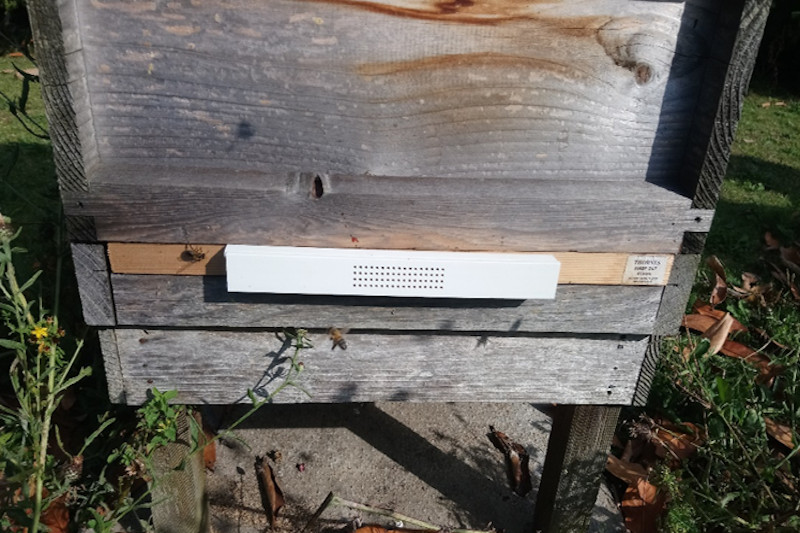August was a fairly wet month, to say the least! For us beekeepers, it never seems to be ‘ideal’ beekeeping weather; either too wet and cold to open up the hive or too hot to tolerate a beesuit. However, it is important to remember that there are jobs that need doing, whatever the weather.
This month, as the wasp situation worsened, we installed ‘wasp-outs’ in some of the hives that looked like they were being targeted by wasps. This is like an entrance block but with extra defences! As you can see from the picture, the ‘wasp out’ has a vented front and entrances either side. This confuses wasps but the bees seem to work it out fairly quickly. The occasional wasp may find its way in, but it does drastically reduce the number that can freely enter and also the amount of space the bees have to guard. Smaller colonies definitely benefit from this little contraption as they are the first to succumb to any wasp invasions.
Big news further field is the confirmed sighting of an Asian Hornet in Tamworth in the last few days. These hornets pose a serious threat to our honey bees so being able to correctly identify them is essential not just for beekeepers but for the general population. In the same vein, it is also very important to be able to distinguish them from a European hornet; this saves experts from wasting time following false leads. We keep Asian Hornet monitoring traps at Rand and empty them regularly. This is important because it means any species you might catch that are not Asian Hornet can be released back into the wild (and yes, that includes the European hornet!). Here you can see we caught some beetles, which we quickly set free.

Another job closer to home and one which is arguably more urgent is to keep the colonies’ stores all stocked up. One major reason our colonies die out at this time of year is due to starvation and this has a lot to do with beekeepers harvesting honey without leaving them sufficient stores or providing them with an alternative food source. However, bees can starve even without the beekeeper’s intervention at this time of year, as many of the flowers that the bees were previously foraging on, are now not in flower. With this in mind, we have fed the bees with Ambrosia syrup using English feeders and an eke. This will, fingers crossed, keep the bees going and give them a good headstart into winter (an unthinkable prospect for us this early in the year, but essential to consider for the bees’ welfare).
In terms of varroa, we have been fairly lucky with the colonies here at Rand. There do not seem to be many hives with indications of varroa, such as Deformed Wing Virus, stunted abdominal growth or Parasitic Mite Syndrome. However, we will inspect the hives again in September and decide then on which treatment we think would work best for us and the bees. Varroa levels tend to increase in Autumn, so it would be unwise to rest on our laurels and say our colonies do not have varroa, because they most probably do!





